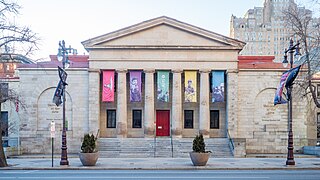
The School of the Art Institute of Chicago (SAIC) is a private art school associated with the Art Institute of Chicago (AIC) in Chicago, Illinois. Tracing its history to an art students' cooperative founded in 1866, which grew into the museum and school, SAIC has been accredited since 1936 by the Higher Learning Commission and by the National Association of Schools of Art and Design since 1944. It has been a member of the Association of Independent Colleges of Art and Design (AICAD) since the association's founding in 1991 and is also accredited by the National Architectural Accrediting Board.

University of the Arts (UArts) was a private arts university in Philadelphia, Pennsylvania. Its campus made up part of the Avenue of the Arts cultural district in Center City, Philadelphia. On May 31, 2024, university administrators suddenly announced that the university would close on June 7, 2024, although its precarious financial situation had been known for some time. It was accredited by the Middle States Commission on Higher Education.

NSCAD University, also known as the Nova Scotia College of Art and Design (NSCAD), is a public art university in Halifax, Nova Scotia, Canada. The university is a co-educational institution that offers bachelor's and master's degrees. The university also provides continuing education services through its School of Extended Studies.

The School of the Museum of Fine Arts at Tufts University is the art school of Tufts University, a private research university in Boston, Massachusetts. It offers undergraduate and graduate degrees dedicated to the visual arts.
The Minneapolis College of Art and Design (MCAD) is a private college specializing in the visual arts and located in Minneapolis, Minnesota. MCAD currently enrolls approximately 800 students. MCAD is one of just a few major art schools to offer a major in comic art.

Ringling College of Art and Design is a private art and design school in Sarasota, Florida. It was founded by Ludd M. Spivey as an art school in 1931 as a remote branch of Southern College before their separation in 1933.

The Kansas City Art Institute (KCAI) is a private art school in Kansas City, Missouri. The college was founded in 1885 and is an accredited by the National Association of Schools of Art and Design and Higher Learning Commission. The institute has approximately 75 faculty members and 700 students, and offers a Bachelor of Fine Arts degree.
The Maryland Institute College of Art (MICA) is a private art and design college in Baltimore, Maryland. Founded in 1826 as the Maryland Institute for the Promotion of the Mechanic Arts, it is regarded as one of the oldest art colleges in the United States.

Edinburgh College of Art (ECA) is one of eleven schools in the College of Arts, Humanities and Social Sciences at the University of Edinburgh. Tracing its history back to 1760, it provides higher education in art and design, architecture, history of art, and music disciplines for over three thousand students and is at the forefront of research and research-led teaching in the creative arts, humanities, and creative technologies. ECA comprises five subject areas: School of Art, Reid School of Music, School of Design, School of History of Art, and Edinburgh School of Architecture & Landscape Architecture (ESALA). ECA is mainly located in the Old Town of Edinburgh, overlooking the Grassmarket; the Lauriston Place campus is located in the University of Edinburgh's Central Area Campus, not far from George Square.

The Pennsylvania Academy of the Fine Arts (PAFA) is a museum and private art school in Philadelphia, Pennsylvania. It was founded in 1805 and is the first and oldest art museum and art school in the United States.

The Cleveland Institute of Art, previously Cleveland School of Art, is a private college focused on art and design and located in Cleveland, Ohio.

The Pacific Northwest College of Art (PNCA) is an art school of Willamette University and is located in Portland, Oregon. Established in 1909, the art school grants Bachelor of Fine Arts degrees and graduate degrees including the Master of Fine Arts (MFA) and Master of Arts (MA) degrees. It has an enrollment of about 500 students. The college merged with Willamette University in 2021.
The Tyler School of Art and Architecture is part of Temple University, a large, urban, public research university in Philadelphia, Pennsylvania, United States. Tyler currently enrolls about 1,350 undergraduate students and about 200 graduate students in a wide variety of academic degree programs, including architecture, art education, art history, art therapy, ceramics, city and regional planning, community arts practices, community development, facilities management, fibers and material studies, glass, graphic and interactive design, historic preservation, horticulture, landscape architecture, metals/jewelry/CAD-CAM, painting, photography, printmaking, sculpture and visual studies.

The Corcoran School of the Arts and Design is the professional art school of the George Washington University, in Washington, D.C. Founded in 1878, the school is housed in the Corcoran Gallery of Art, the oldest private cultural institution in Washington, located on The Ellipse, facing the White House. The Corcoran School is part of GW's Columbian College of Arts and Sciences and was formerly an independent college, until 2014.

Massachusetts College of Art and Design, branded as MassArt, is a public college of visual and applied art in Boston, Massachusetts. Founded in 1873, it is one of the nation's oldest art schools, and the only publicly funded independent art school in the United States. It was the first art college in the United States to grant an artistic degree.

The Art Academy of Cincinnati is a private college of art and design in Cincinnati, Ohio. It was founded as the McMicken School of Design in 1869, and was a department of the University of Cincinnati, and later in 1887, became the Art Academy of Cincinnati, the museum school of the Cincinnati Art Museum. The college is accredited by the National Association of Schools of Art and Design.

The Yale School of Art is the art school of Yale University. Founded in 1869 as the first professional fine arts school in the United States, it grants Masters of Fine Arts degrees to students completing a two-year course in graphic design, painting/printmaking, photography, or sculpture.

Jerry W. McDaniel is an American heterogeneous artist; graphics artist, illustrator, communication designer, educator and modernist painter. He distinguished himself by doing advertising work for numerous large corporations, creating posters, doing book and magazine illustrations, and influencing numerous students of advertising and communication design. In parallel with his commercial career he was a prolific multimedia artist, painting in acrylic and in watercolor, in various fields such as landscape, portraits, sports, and political graphics. He also designed sports stamps. He was one of the first illustrators to embrace computer graphics.

Moore College of Art & Design is a private art school in Philadelphia, Pennsylvania. It was founded in 1848 by Sarah Worthington Peter as the Philadelphia School of Design for Women, and was renamed the Moore College of Art & Design in 1989. Although the school's undergraduate programs were historically only open to women, Moore opened admission to transgender, nonbinary, and gender-nonconforming students in 2020. Its other educational programs, including graduate programs and youth programs, are co-educational.
Harold Zisla was an American abstract expressionist painter and art educator. In 1968 he became the founding chair of the Fine Arts Department at Indiana University South Bend, where he taught until his retirement in 1989.
























